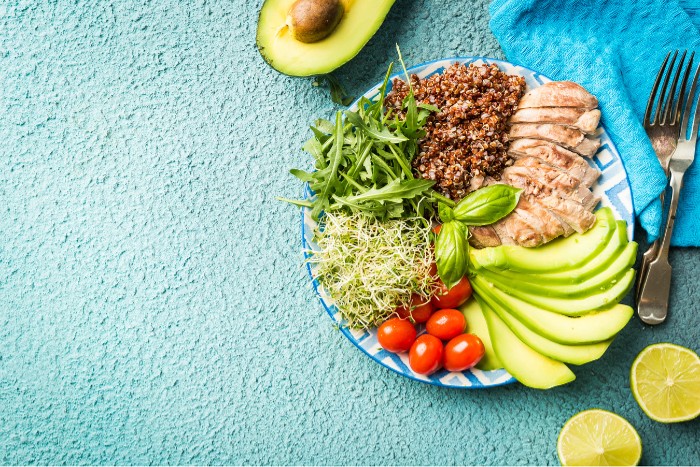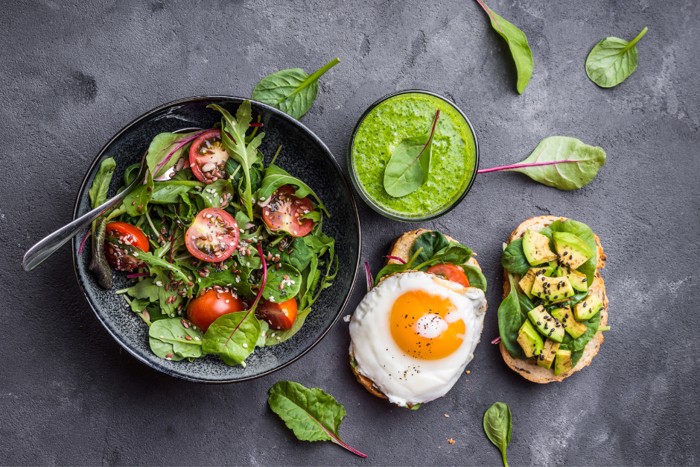
Recently I joined Function Health to get an overall picture of my health. It was eye opening! I thought I was way healthier than I actually am. I discovered I have high cholesterol and I’m low on omega 3 and Vitamin D among other health concerns. I’ll get to those in later posts.
Since getting those results, I’ve been more mindful of macronutrients and micronutrients. I’m a big believer in getting as much as you can from the foods you eat rather than a supplement. My focus has been to create meals that include those micronutrients I need to fix those health issues and ensure I’m getting the right balance of macronutrients, and it’s been a lot of fun.
I’ve learned a lot about creating balanced meals and want to share that with you.

Photo by Roxiller from Getty Images on Canva
Balanced eating is crucial for maintaining overall health, energy, and wellbeing. Here’s why:
- A balanced diet provides the nutrients your body needs to function optimally. Each nutrient plays a unique role – proteins repair tissues, carbohydrates provide energy, fats support brain health, and vitamins and minerals regulate bodily processes.
- Consistently eating a variety of nutritious foods reduces the risk of chronic diseases like heart disease, diabetes, and obesity. Balanced eating helps prevent nutrient deficiencies that can impact immunity, bone health, and mental clarity.
- Consuming a mix of macronutrients ensures steady energy throughout the day. It minimizes energy crashes and keeps you productive.
- Certain nutrients, like omega-3 fatty acids and complex carbohydrates, are associated with better mood and cognitive function. Balanced eating also supports the gut-brain connection, which influences emotional wellbeing.
- Balanced eating fuels physical and mental performance, helps you recover faster, and boosts overall vitality, allowing you to enjoy life to its fullest.
What is balanced eating? There are 5 principles that align with the standard “plate” and ensure you’re not overeating and maintaining energy and clarity throughout the day.
- Incorporate All the Food Groups
- Half the plate should be filled with colorful fruits and vegetables. Aim for a variety of colors to ensure you get a wide range of vitamins, minerals, and antioxidants. Think leafy greens, cruciferous veggies, bell peppers, carrots, and fresh fruits.
- A quarter of the plate should be whole grains or healthy carbs. Include sources like quinoa, brown rice, whole grain bread, or oats. These provide energy, fiber, and essential nutrients.
- A quarter of the plate should be lean proteins. Choose options like chicken, fish, eggs, beans, lentils, tofu, or nuts. Proteins support tissue repair, muscle growth, and satiety.
- Note: This is a typical balanced plate. If you are following a specific diet, trying to lose weight, or correcting some other issue, you may be changing the percentages down. i.e. trying to lose weight?, you might consider more protein and less whole grains.
- Portion Control and Timing
- Maintaining balanced portions prevents overeating and keeps energy levels stable. Paying attention to hunger and fullness cues is key.
- Healthy Fats
- Don’t forget to add a small portion of healthy fats for your brain and heart health. Olive oil, avocado slices, nuts, and seeds are all good sources.
- Hydration
- A balanced meal pairs well with water or herbal tea for hydration, helping digestion and overall energy balance.
- Moderation
- There’s room for all foods, including your favorite treats. The idea is to enjoy them in moderation without guilt or overindulgence.
Creating a balanced meal can be challenging and a lot of work. However, with some thoughtful strategies it can be simple and enjoyable. Here are a few tips to make this easier.
- Plan Ahead
- Before grocery shopping, plan meals for the week.
- Choose recipes that incorporate a variety of nutrients to avoid monotony and ensure diversity.
- Batch Cook and Portion
- Cook proteins and grains in bulk. Store them separately so you can mix and match during the week.
- Use portion-sized containers to make grab-and-go meals.
- Incorporate Color
- Fill your meals with a rainbow of fruits and vegetables. Each color often represents different nutrients, so the more variety, the better.
- Include Healthy Fats
- Add small portions of healthy fats like avocados, nuts, or drizzle of olive oil to meals.
- Make Use of Spices and Herbs
- Enhance flavors without adding extra salt or sugar.
- Prep Snacks Too
- Have pre-cut veggies with hummus, yogurt with fruit, or a handful of nuts ready to curb hunger between meals.
Balanced eating is all about giving your body the nutrients it needs to function at its best, while maintaining harmony in your diet. It focuses on variety, moderation, and mindful choices to ensure your meals are nourishing and satisfying.





Leave a Reply